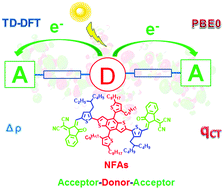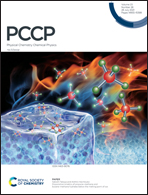Evaluating the nature of the vertical excited states of fused-ring electron acceptors using TD-DFT and density-based charge transfer†
Abstract
Acceptor–donor–acceptor structured fused-ring electron acceptors (FREAs) are the most efficient electron acceptors used in organic solar cells. We use density functional theory (DFT), its time-dependent version (TD-DFT), and an intra-molecular charge transfer index to evaluate the nature of the excited states of FREAs. Typically, several efficient electronic transitions contribute to the absorption spectra of FREAs. An investigation of every efficient electronic transition of each FREA is performed based on the electronic density variation in the donor and acceptor moieties of the molecules upon absorbing solar photons. Not all these transitions are equivalent for light-to-electricity conversion. The first transition contributes the most to the absorption spectra. This transition is intense and extremely efficient for light-to-electricity conversion, giving a higher value of intra-molecular charge transfer. For certain effective transitions of FREAs, the phenyl rings in the donor unit behave as the electron-donating units, such as IDT-NTI-2EH, BTCN-M, and MeIC. The foremost finding of the present research work is that the furthermost strong electronic transitions are not essentially the most effective ones for the conversion of sunlight into electricity.



 Please wait while we load your content...
Please wait while we load your content...